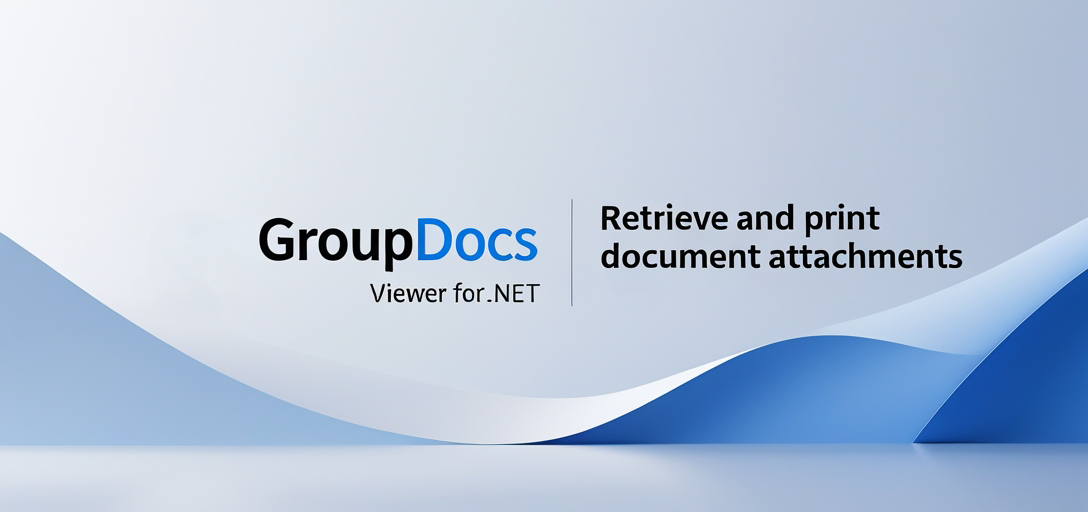How to Retrieve and Print Document Attachments Using GroupDocs.Viewer for .NET | Advanced Rendering Guide
Introduction
Are you looking for an efficient way to manage document attachments? Extracting metadata or listing all attached files can be cumbersome tasks without the right tools. This tutorial will guide you through retrieving and printing document attachments using GroupDocs.Viewer for .NET, a powerful library that simplifies these processes.

By following this guide, you’ll learn how to:
- Set up GroupDocs.Viewer in your .NET project
- Retrieve all attachments from a document
- Print the details of each attachment
Dive into seamless document management with GroupDocs.Viewer for .NET. Let’s ensure you have everything ready before we start.
Prerequisites
Before diving into coding, prepare the following:
Required Libraries and Dependencies:
- GroupDocs.Viewer: A robust library for handling documents in .NET applications.
- .NET Framework or .NET Core/5+: Make sure your development environment is set up with the appropriate version.
Environment Setup:
- Visual Studio (2017 or later) installed on your machine
- Basic understanding of C# and .NET project structure
Setting Up GroupDocs.Viewer for .NET
To start, install GroupDocs.Viewer in your .NET project using either the NuGet Package Manager Console or the .NET CLI.
Installation with NuGet Package Manager Console:
dotnet add package GroupDocs.Viewer --version 25.3.0
Installation with .NET CLI:
dotnet add package GroupDocs.Viewer --version 25.3.0
Once installed, configure your project to use the library.
License Acquisition Steps:
- Free Trial: Download a trial version from GroupDocs Downloads.
- Temporary License: Request a temporary license via their Temporary License Page.
- Purchase: Consider purchasing a full license for access and support on the GroupDocs Purchase page.
Basic Initialization and Setup:
Here’s how you can initialize GroupDocs.Viewer in your C# code:
using System;
using GroupDocs.Viewer;
namespace DocumentAttachmentDemo
{
class Program
{
static void Main(string[] args)
{
// Initialize the Viewer object with your document's path
using (Viewer viewer = new Viewer(@"YOUR_DOCUMENT_DIRECTORY/SAMPLE_MSG_WITH_ATTACHMENTS"))
{
// Your code here...
}
}
}
}
Implementation Guide
Now, let’s focus on retrieving and printing document attachments.
Retrieve All Attachments from a Document
Overview
This section demonstrates how to extract all attachments embedded within a document using GroupDocs.Viewer for .NET.
Step 1: Initialize the Viewer Object
Create an instance of the Viewer class by specifying your document’s path. This prepares the environment for processing.
using System;
using System.Collections.Generic;
using GroupDocs.Viewer;
namespace DocumentAttachmentDemo
{
class Program
{
static void Main(string[] args)
{
// Path to your document with attachments
string filePath = @"YOUR_DOCUMENT_DIRECTORY/SAMPLE_MSG_WITH_ATTACHMENTS";
using (Viewer viewer = new Viewer(filePath))
{
// Retrieve attachments in the next step...
}
}
}
}
Step 2: Retrieve Attachments from the Document
Use the GetAttachments method to fetch all attachments. This returns a list of attachment objects with metadata like name and size.
using System.Collections.Generic;
using GroupDocs.Viewer;
namespace DocumentAttachmentDemo
{
class Program
{
static void Main(string[] args)
{
string filePath = @"YOUR_DOCUMENT_DIRECTORY/SAMPLE_MSG_WITH_ATTACHMENTS";
using (Viewer viewer = new Viewer(filePath))
{
// Retrieve attachments
IList<Attachment> attachments = viewer.GetAttachments();
// Proceed to print attachment details...
}
}
}
}
Step 3: Print Each Attachment’s Details
Iterate over the retrieved list and display each attachment’s name and size. This verifies the retrieval process.
using System;
using System.Collections.Generic;
using GroupDocs.Viewer;
namespace DocumentAttachmentDemo
{
class Program
{
static void Main(string[] args)
{
string filePath = @"YOUR_DOCUMENT_DIRECTORY/SAMPLE_MSG_WITH_ATTACHMENTS";
using (Viewer viewer = new Viewer(filePath))
{
IList<Attachment> attachments = viewer.GetAttachments();
foreach(Attachment attachment in attachments)
{
Console.WriteLine($"Name: {attachment.Name}"); // Display attachment name
Console.WriteLine($"Size: {attachment.Size}"); // Display attachment size
}
}
}
}
}
Troubleshooting Tips
- Document Path Error: Ensure the document path is correct and accessible.
- Permission Issues: Check if your application has read permissions for the specified directory.
Practical Applications
Here are some real-world scenarios where retrieving and printing document attachments can be useful:
- Email Management Systems: Automate extraction of attachments from emails to streamline processing.
- Document Review Platforms: Enhance review processes by making all attachments readily available.
- Legal Document Handling: Quickly access all attachments for comprehensive case management.
Integration possibilities include connecting with CRM systems or document storage solutions like SharePoint and Azure Blob Storage.
Performance Considerations
Optimizing performance is crucial when dealing with large documents:
- Resource Management: Always use the
usingstatement to ensure proper disposal of resources. - Batch Processing: If handling multiple documents, consider processing them in batches to reduce memory load.
- Efficient Data Structures: Use appropriate data structures for storing and accessing attachment metadata.
Conclusion
In this tutorial, you learned how to retrieve and print document attachments using GroupDocs.Viewer for .NET. This powerful library simplifies handling attachments and integrates seamlessly with other .NET systems.
As next steps, explore more features of GroupDocs.Viewer by diving into their documentation or experimenting with different file formats. Why not try implementing these techniques in your own projects?
FAQ Section
Q1: How do I handle encrypted documents?
- Ensure you have the necessary decryption keys or passwords and pass them to the Viewer initialization.
Q2: Can GroupDocs.Viewer handle all document types?
- It supports a wide range of formats, including PDFs, Word docs, and spreadsheets. Check their API reference for specifics.
Q3: Is there a limit to the number of attachments I can retrieve?
- No inherent limits exist, but performance may vary with document size and system resources.
Q4: How do I troubleshoot common errors?
- Review error messages carefully and consult GroupDocs’ support forum for assistance.
Q5: What are the benefits of using a temporary license?
- A temporary license allows full access to features, facilitating thorough testing before purchase.